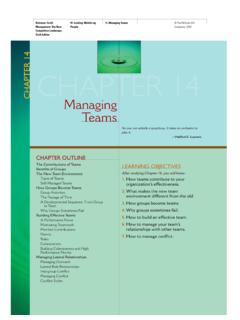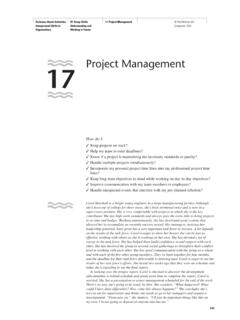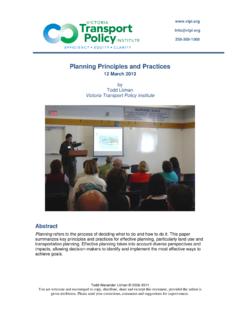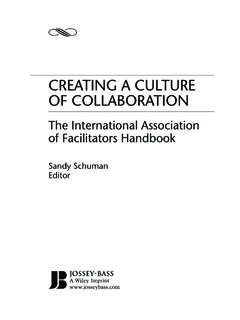Transcription of 314397 CH 07 - apollolibrary.com
1 Conflict andCohesion inGroupsChapter OutlineConflict in GroupsSubstantive ConflictProcedural ConflictAffective ConflictConstructive andDestructive ConflictConflict StylesAvoidanceAccommodationCompetitionC ompromiseCollaborationChoosing a Conflict StyleApproaches to ConflictManagementThe 4Rs MethodThe A-E-I-O-U ModelNegotiationMediationArbitrationGrou p CohesionEnhancing CohesionGroupthinkAdapting to DifferencesBalancing Conflict 10/23/03 8:59 AM Page 146conflict in groupsConflict is unavoidable in an effective group. Rarely do conscientious memberswork in groups for any length of time without expressing differences and dis-agreeing. Yet despite the inevitability of conflict, many of us go out of our wayto avoid or suppress it. One of the myths about effective groups is that they arecharacterized by chumminess. Many effective teams look more like battle-grounds, it turns out.. Teams with vastly competent members embrace con-flict as the price of synergy and set good idea against good idea to arrive at thebest idea.
2 1 The word conflictis frequently associated with quarreling, fighting, anger,and hostility. While these elements may be present in a group situation, conflict does not have to involve the expression of negative emotions. We defineconflictas the disagreement and disharmony that occurs in groups when dif-ferences are expressed regarding ideas, methods, and/or members. When treatedas an expression of legitimate differences, conflict can be used as the spur tofind the wider solution, the solution that will meet the mutual interest of theparties involved in it. 2 Putnam has classified the sources of conflict as substantive, procedural, Substantive ConflictSubstantive conflictis disagreement over members ideas and group issues. Forexample, when members of a student government council argue whether or notstudent activities fees should be raised, their conflict is substantive. Such con-flict is directly related to working toward the group s goal of serving students cocurricular needs.
3 Procedural ConflictProcedural conflictis disagreement among group members about the methodsor process the group should follow in its attempt to accomplish a goal. Whereas147 FIGURE of 10/23/03 8:59 AM Page 147some group members may want to begin a discussion by suggesting solutions toa problem, others may want to start by gathering and discussing members may believe that a decision should be made by secret ballotwhile others may want a show of hands. Affective ConflictAffective conflictcenters around the personalities, communication styles, andemotions of group members. Its causes are numerous. Affective conflict mayoccur when a member does not feel valued or is threatened by the conflict also occurs when members believe that their ideas are notjudged fairly or when group members are struggling for power. Affective con-flict is more difficult to resolve because it involves people s feelings and the waymembers relate to one when disagreement occurs in groups, both substantive and affec-tive types of conflict are present.
4 For example, Dee believes student fees shouldbe raised in order to fund more campus activities. Charles disagrees and suggeststhat the existing funds should be used more efficiently rather than placing alarger financial burden on students. At this point in the discussion, the conflictis substantive; it is focused on issues. However, when responding to Dee,Charles rolls his eyes and states that only a political fool believes that higherfees are the answer to the problem. Not only does Dee disagree with Charleson the issues, but she is also angered by his comment. Now the conflict is notjust substantive; it has become affective as and Destructive ConflictConflict itself is neither good nor bad. However, the way in which a group dealswith conflict can be constructive or conflictresults when groups engage in behaviors that createhostility and prevent achievement of the group s goal. Constant complaining,personal insults, conflict avoidance, and loud arguments or threats all con-tribute to destructive quality of group decision making deterio-rates when members are inflexible and not open to other points of conflict has the potential to permanently disable a conflictresults when group members express disagreement ina way that values everyone s contributions and promotes the group s goal.
5 Characterizes the differences between destructive and constructive committed to constructive conflict abide by the following principles:5 Disagreement is not punished. I m not afraid of being fired for disagreeing with other members. 148 PART IIInteraction 10/23/03 8:59 AM Page 148 Members work with each other to achieve a mutually satisfying resolutionof conflict. We can work this out. After all, we re all after the same thing in the longrun. Lower-status members are free to disagree with higher-status group members. I know she s the CEO, but I think there are some disadvantages to theapproach she suggests. The group has an agreed-upon approach for conflict resolution and deci-sion making. Our group is using the Nominal Group Technique, so I know my ideaswill be heard and included. Members can disagree and still respect each other. The group may not like my idea, but members would never personallyattack me for expressing my opinion. Constructive group conflict has many positive outcomes.
6 Issues and peopleare better understood through an open exchange. The quality of decision mak-ing improves as opposing viewpoints and concerns are discussed. Expressing dif-ferences constructively can make a group discussion more interesting andpromote StylesThere are many ways of identifying and classifying different styles of of the most preferred methods suggests that individuals are predisposed tousing one of the following five conflict styles: avoidance, accommodation, com-petition, compromise, and five styles can be furtherunderstood by examining the extent to which a group member s approach toconflict is focused on achieving personal goals and/or the group s goal. Members7: Conflict and Cohesion in Groups149 FIGURE andDestructiveConflictConstructive ConflictDestructive Conflict Focus on Issues Personal Attacks Respect for Others Insults Supportiveness Defensiveness Flexibility Inflexibility Cooperation Competition Commitment to Conflict Management Avoidance of 10/23/03 8:59 AM Page 149who are motivated to achieve their own goals tend to choose more competitiveapproaches.
7 Cooperative members are usually more concerned with achievingthe group s goals. Figure illustrates the relationship of each conflict style toa group member s motivation. AvoidanceWhen members are unable or unwilling to accomplish their own goals or con-tribute to achieving the group s goal, they may adopt the avoidance members using this style may change the subject, avoid bringingup a controversial issue, and even deny that a conflict exists. Avoiding conflictin groups is usually counterproductive because it fails to address a problem andcan increase group tensions. Furthermore, ignoring or avoiding conflict doesnot make it go , in some circumstances, avoidance of conflict can be an appropri-ate approach, specifically when the issue is not that important to you. you need to take time to collect your thoughts or control your emotions. other group members are effectively addressing the same concerns. the consequences of confrontation are too risky.
8 AccommodationGroup members using the accommodating conflict stylegive in to other mem-bers at the expense of their own goals. A genuine desire to get along with other150 PART IIInteraction SkillsHighLowCOMPETITION I win; you lose. COMPROMISE Give a little; get a little. COLLABORATION We win! AVOIDANCE Leave me alone. ACCOMMODATION I give in. LowHighConcern forGroup GoalsConcernfor OwnGoalsFIGURE 10/23/03 8:59 AM Page 150group members is often the motivation of accommodators. Such membersbelieve that giving in to others serves the needs of the group even when thegroup could benefit from further discussion. A group member who alwaysapproaches conflict by accommodating others may ultimately be perceived asless powerful and have less influence in group decision during conflict can be an appropriate approach when the issue is very important to others but not very important to you. it is more important to preserve group harmony than to resolve the currentissue.
9 You realize you are wrong or have changed your mind. you are unlikely to succeed in persuading the group to adopt your position. CompetitionThe competitive conflict styleoccurs when group members are more concernedwith their own goals than with meeting the needs of the group. Competitivemembers want to win; they argue that their ideas are superior to the alternativessuggested by others. When used inappropriately, the competitive style may be characterized by hostility, ridicule, and personal attacks against group mem-bers. Approaching conflict competitively tends to reduce group members towinners and losers. Ultimately, this may damage the relationships among certain group situations, however, the competitive approach may be themost appropriate style. Approach conflict competitively when you have strong beliefs about an important issue. the group must act immediately on an urgent issue or emergency situation. the consequences of the group s decision may be very serious or harmful.
10 You believe the group may be acting unethically or illegally. CompromiseThe compromising conflict styleis a middle ground approach that involvesconceding some goals in order to achieve others. When group members com-promise, each member is willing to suffer some losses in exchange for gainingsomething else. Group members who approach conflict through compromiseargue that it is a fair method of resolving problems since everyone loses equally. However, when each person gives up something in order to meet the othershalfway, the result is only partial satisfaction for all concerned. Commitment tosolutions will be questionable. 77: Conflict and Cohesion in 10/23/03 8:59 AM Page 151 The compromise approach should be used when the group has been unableto find a more constructive solution. Groups should consider compromisingwhen other methods of resolving the conflict will not be effective. the members have reached an impasse and are no longer progressingtoward a reasonable solution.















